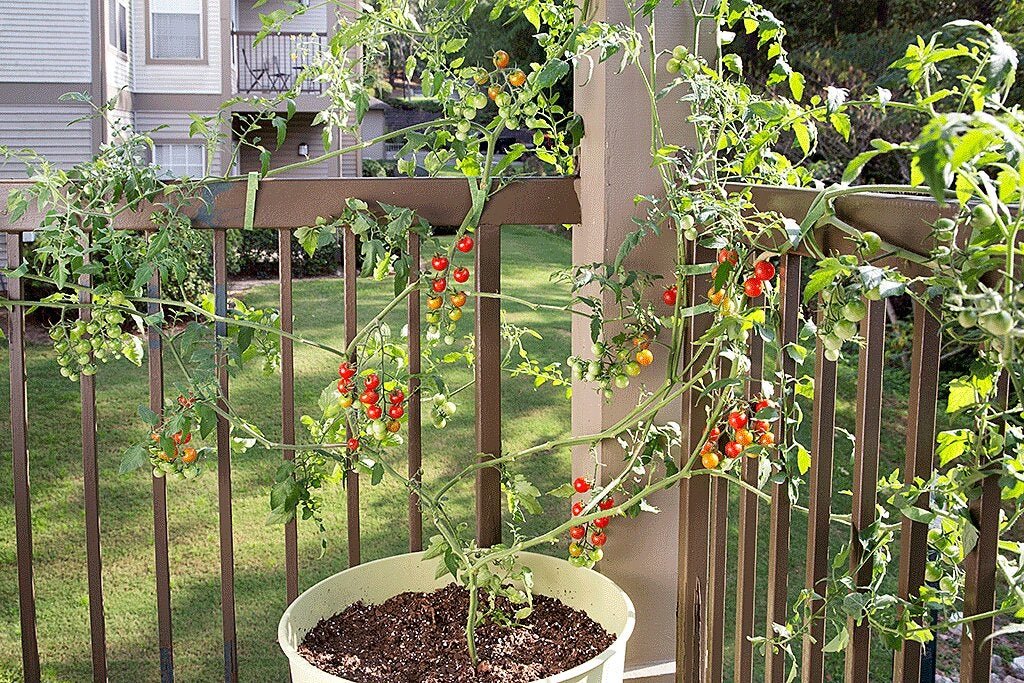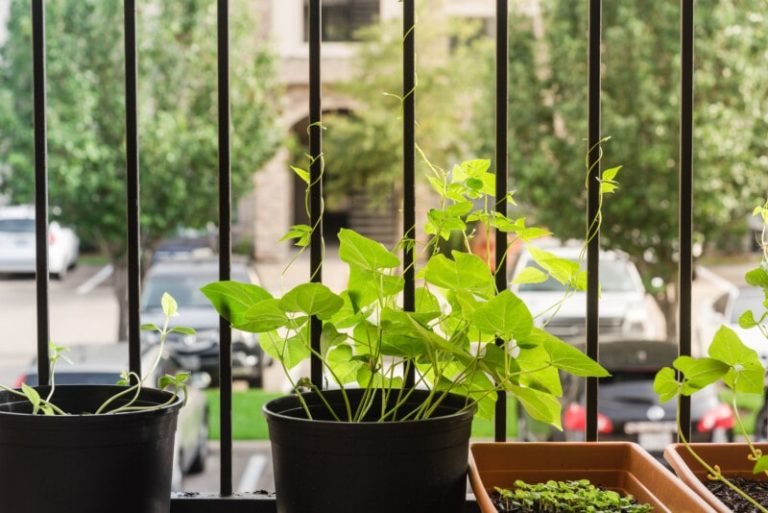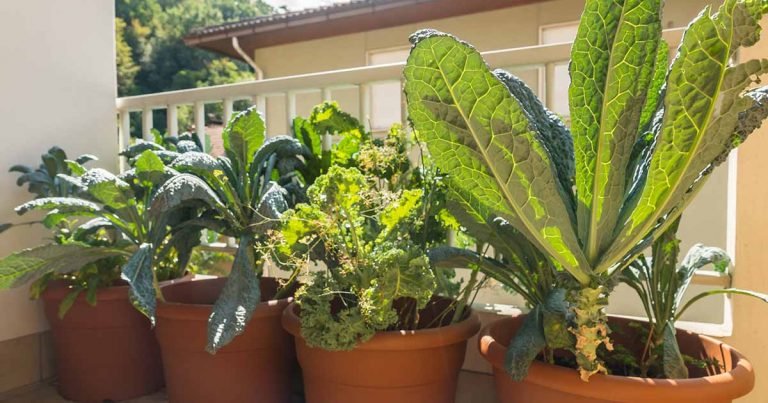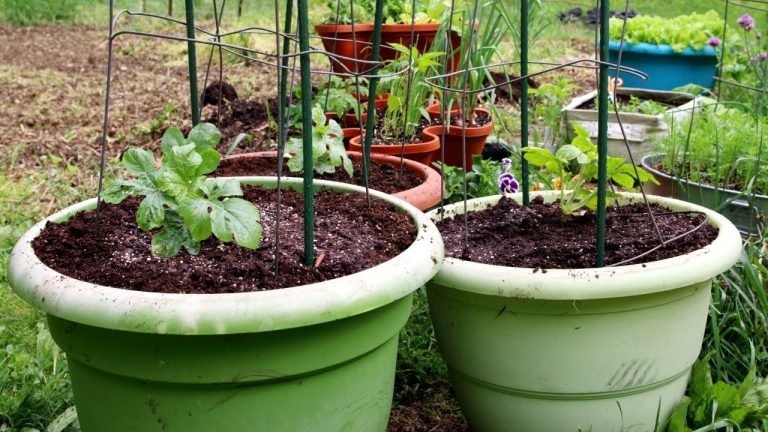How to Grow Cherry Tomatoes in a Pot – [Beginners Guide]
Are you looking for a fun and easy way to grow your own produce at home? Consider giving cherry tomatoes a try! Not only are they delicious and versatile in the kitchen, but they’re also well-suited for growing in pots.
I have personally grown cherry tomatoes in pots for many years and can attest to their ease and success. With a little bit of planning and care, you can enjoy a bountiful harvest of sweet and juicy cherry tomatoes right in your own backyard.
In this guide, we’ll go over how to successfully grow cherry tomatoes in a pot, from choosing the right variety to watering and fertilizing. We’ll also discuss some common problems and how to troubleshoot them.
So, are you ready to give it a go? Let’s get started!
Pot or container selection
When it comes to growing cherry tomatoes at home, choosing the right pot is crucial for the success of your plants. Here are some things to consider when selecting a pot for your cherry tomatoes:
Size and capacity
Cherry tomatoes need plenty of room to grow, so it’s important to choose a pot that is large enough to accommodate your plants. As a general rule, you should aim for a pot that is at least 12 inches (30 cm) in diameter and 12 inches (30 cm) deep. This will give your plants enough space to spread their roots and grow to their full potential.
If you have limited space, you can opt for a smaller pot, but be aware that your plants may not be as productive. You can also use a hanging basket or a vertical planter if you don’t have room for a large pot on the ground.
Construction
The construction of your pot is also important for the health of your cherry tomatoes. Here are some things to consider:
- Material: Choose a pot that is made of a durable material, such as ceramic, plastic, or fiberglass. Avoid pots made of metal or wood, as they may leach chemicals into the soil or rot over time.
- Drainage: Make sure your pot has drainage holes in the bottom to allow excess water to drain out. If your pot doesn’t have drainage holes, you can drill some yourself or add a layer of rocks or gravel in the bottom to help with drainage.
- Style: You can choose a pot with a decorative design or a more utilitarian style, depending on your preference. Just be sure to choose a pot that is functional and well-suited for growing cherry tomatoes.
By choosing the right size and construction for your pot, you can give your cherry tomatoes the best chance at success.
Make suitable soil mix
The type of soil you use for your cherry tomatoes is crucial for their growth and development. Here are some things to consider when selecting soil for your cherry tomatoes:
Type
It’s best to use a high-quality potting mix specifically formulated for tomatoes. These mixes are usually made from a combination of peat moss, compost, and perlite or vermiculite, and are designed to provide the right balance of nutrients and drainage for your plants.
Avoid using garden soil or topsoil, as these types of soil may not have the right composition for container-grown plants. They may also contain weed seeds or pathogens that can harm your cherry tomatoes.
Mixture
In addition to using a high-quality potting mix, you may also want to consider adding some amendments to your soil to give your cherry tomatoes a boost. Some options include:
- Compost: Adding compost to your soil can help improve its structure, drainage, and nutrient content.
- Organic fertilizers: You can use organic fertilizers, such as bone meal or blood meal, to provide additional nutrients for your plants.
- pH adjusters: Cherry tomatoes prefer a slightly acidic soil pH (between 6.0 and 6.8). You can use sulfur or aluminum sulfate to lower the pH of your soil, or lime to raise it.
By choosing the right soil mix and adding the right amendments, you can give your cherry tomatoes will have a high chance of growing optimally.
How to plant the Cherry Tomatoes?
Planting cherry tomatoes in pots is a fun and easy way to grow your own produce at home. Here’s a step-by-step guide to help you get started:
Step 1: Choose the right pot
Select a pot that is large enough to accommodate the root system of your cherry tomato plant. A pot with a diameter of at least 12 inches and a depth of at least 12 inches is a good size for most cherry tomato varieties.
Make sure the pot has drainage holes to allow excess water to drain away from the roots. If the pot doesn’t have drainage holes, be sure to add some to the bottom before planting.
Step 2: Fill the pot with soil
Fill the pot with a high-quality potting mix formulated for tomatoes. Make sure to leave enough space at the top of the pot for watering and for adding a stake or cage if needed.
Step 3: Plant the cherry tomato seedling
Remove the cherry tomato seedling from its container, taking care to gently loosen the roots. Place the seedling in the center of the pot, making sure that the root ball is level with the soil surface.
Fill in around the root ball with soil, gently tamping it down to remove any air pockets. Water the seedling well to help settle the soil around the roots.
Step 4: Support the plant
Some cherry tomato varieties may need support as they grow. If your plant is tall or if it produces heavy fruit, consider adding a stake or cage to the pot to help support the plant.
Be sure to place the stake or cage in the pot before the plant grows too large, as it can be difficult to add one later without damaging the roots.
Step 5: Water and fertilize
Keep the soil moist, but be careful not to overwater. A good rule of thumb is to water the soil deeply once or twice a week, depending on the weather and the size of the pot.
As the plant grows, you may want to fertilize it with a balanced tomato fertilizer to help it continue to thrive. Follow the instructions on the fertilizer package for the recommended amount and frequency.
With a little care and attention, your cherry tomato plant will reward you with a bountiful harvest of delicious, homegrown tomatoes.
How to care for Cherry Tomatoes?
Watering Requirement
When it comes to watering cherry tomatoes, it’s important to strike a balance. Overwatering can lead to problems such as root rot, while underwatering can cause the plants to wilt and the fruit to become less flavorful. As a general rule of thumb, water your cherry tomato plants deeply once or twice a week, depending on the weather and soil conditions. Check the soil moisture level by sticking your finger about an inch into the soil. If it feels dry at that depth, it’s time to water.
Fertilizer Requirement
Cherry tomatoes are heavy feeders and will benefit from a steady supply of nutrients. Use a balanced fertilizer, such as a 10-10-10 formula, according to the package directions. Alternatively, you can use a slow-release fertilizer or compost to provide a steady supply of nutrients over time. Avoid overfertilizing, as this can lead to excessive foliage growth at the expense of fruit production.
Sunlight Needs
Cherry tomatoes need plenty of sunlight to thrive, so choose a spot in your garden or patio that gets at least 6 hours of direct sunlight per day. If you don’t have a sunny spot outdoors, you can also grow cherry tomatoes in a sunny window indoors using a grow light.
Pruning & Training
Pruning and training cherry tomatoes can help improve air circulation, increase sun exposure, and make harvesting easier. To prune, simply remove any suckers (small shoots that grow from the base of the plant) and any yellow or diseased leaves. To train your cherry tomato plants, use stakes or cages to support the plants as they grow. This will help prevent them from falling over and will make it easier to access the fruit.
Other Care
In addition to watering, fertilizing, and pruning, there are a few other things you can do to care for your cherry tomato plants:
- Mulch the soil around the plants to help retain moisture and suppress weeds.
- Use a tomato cage or trellis to support the plants as they grow.
- Pinch off any flowers that appear early in the season. This will allow the plant to focus its energy on root growth and will lead to a more productive harvest later on.
- Be on the lookout for pests and diseases. Common problems include tomato hornworms, aphids, and early blight. If you notice any issues, take action immediately to prevent them from spreading.
Common problems
Growing cherry tomatoes in a pot can be a rewarding and enjoyable experience, but it’s important to be aware of potential issues that may arise. Some common problems that cherry tomatoes grown in pots may face include:
Pests
Cherry tomatoes are prone to pests such as aphids, whiteflies, and tomato hornworms. These pests can cause damage to the leaves and fruit of the plant, and can also spread diseases. To prevent pests, try using natural methods such as introducing beneficial insects, such as ladybugs, or applying organic pest control solutions.
Insects
Insects such as thrips and cutworms can also be a problem for cherry tomatoes grown in pots. Thrips are small, slender insects that feed on the leaves and fruit of the plant, while cutworms are larval stage caterpillars that can cut off young plants at the soil level. To prevent insects, you can use physical barriers such as insect netting or apply organic insecticides.
Diseases
Cherry tomatoes are also prone to diseases such as blight, mosaic virus, and verticillium wilt. These diseases can cause leaf and fruit damage, and can be spread through infected soil or water. To prevent diseases, it’s important to practice good hygiene by cleaning up fallen leaves and fruit, and avoiding overhead watering. Using disease-resistant varieties of cherry tomatoes can also help.
Poor Production
Cherry tomatoes grown in pots may also experience poor production due to various factors such as insufficient sunlight, improper watering, or lack of nutrients. To ensure good production, it’s important to provide your plants with the right amount of sunlight, water them regularly (but don’t overdo it), and fertilize them with a balanced fertilizer according to the package instructions.
Harvesting & storing homegrown Cherry Tomatoes
When to Harvest Cherry Tomatoes
When it comes to harvesting cherry tomatoes, timing is everything. You’ll want to wait until the tomatoes are fully ripe before picking them, as this will ensure that they have the best flavor and texture. Cherry tomatoes will typically be ripe and ready to harvest when they are a deep, rich red color. Some varieties may be yellow, orange, or even purple when ripe, so be sure to check the specific variety you are growing to know what to look for.
In addition to color, you can also tell when cherry tomatoes are ripe by gently squeezing them. Ripe cherry tomatoes should be firm, but give slightly when squeezed. If they are too soft or mushy, they may be overripe and should be used right away. If they are still hard and unyielding, they may need a bit more time on the vine.
As a general rule of thumb, cherry tomatoes will be ready for harvest about 60-80 days after planting, depending on the variety and growing conditions. Keep an eye on your plants and start checking for ripe fruit around this time frame. Be sure to check your plants regularly and harvest any ripe fruit as soon as you see it, as this will encourage the plant to continue producing more fruit.
Storing Cherry Tomatoes
Once you’ve harvested your cherry tomatoes, it’s important to store them properly to ensure that they stay fresh and delicious for as long as possible. Here are a few tips for storing cherry tomatoes:
- Avoid washing the tomatoes until you are ready to use them, as this can cause them to spoil more quickly.
- Store cherry tomatoes at room temperature, away from direct sunlight. Avoid storing them in the fridge, as this can cause them to lose flavor and texture.
- If you have a large harvest and need to store some of the tomatoes for later, you can freeze them. To do this, wash and dry the tomatoes, then place them on a baking sheet and freeze them until solid. Transfer the frozen tomatoes to a resealable bag and store them in the freezer for up to 6 months.
With proper care and storage, your homegrown cherry tomatoes should stay fresh and flavorful for several days to a week. Enjoy them as a snack, in salads, or in any of your favorite recipes.
Growing Cherry Tomatoes in container – Conclusion
Congratulations on making it to the end of this guide on growing cherry tomatoes in a pot! By now, you should have a good understanding of how to choose the right pot and soil mix, plant and care for your cherry tomato plants, and troubleshoot any common problems that may arise.
Growing your own cherry tomatoes at home is a fun and rewarding hobby that can also provide you with delicious, fresh produce. Whether you have a large backyard or just a small balcony, you can enjoy the benefits of homegrown cherry tomatoes with a little bit of planning and effort.
So don’t be afraid to give it a try! With the right pot, soil mix, and care, you’ll be well on your way to harvesting your own cherry tomatoes in no time. Happy gardening!








